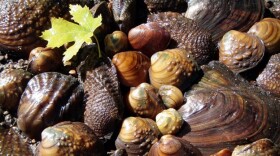Having worked with the wood products industry for nearly 40 years, I have a special appreciation for figured wood, especially burls in wood. Everyone can picture a wood bowl or wood pen turned from a wood burl. The colors, grain swirls, and reflected light show the beauty of this natural material. Don’t get me wrong, “normal” wood is beautiful too, but a burl is something special.
What is a burl and what causes burls to form in growing tree? A burl is a tree growth where the grain has grown in a deformed manner. In normal growth, wood cells (hollow tubes like a drinking straws) are arranged mainly parallel to the long axis of the tree trunk or branch. This is a logical arrangement since water flows from the root system through these straw-like cells up to branches and leaves. Burls deviate from this normal growth pattern. They are commonly found in the form of a rounded outgrowth on a tree trunk or branch. The wood tissue in a burl is extremely disoriented and often contains numerous bud formations. What we can’t normally see is that most burls grow beneath the ground, attached to the roots. Such burls sometimes appear as groups of bulbous protrusions connected by a system of rope-like roots. Burls yield a very peculiar and highly figured wood sought after in woodworking.
Burl formation is typically a result of some form of stress such as an injury, viral, or fungal infection. Insect infestations and certain types of mold infestations are the most common causes. These types of infestations likely trigger a hormonal response causing the wood to grow in irregular patterns. I suspect many of you are familiar with maple gall mites. They form the little bumps on the bottom of silver maple leaves. As the mites feed on the developing leaf tissue, growth regulating chemicals produced by the mites interact with plant hormones causing an abnormal stimulation of cell growth. This abnormal growth forms the galls that gradually enclose the mites. A similar chemical reaction is likely at work during burl formation.
Whether a burl is small or large, it has little effect on the lifespan of the tree. The tree trunk or branch still has normal wood under the burl to provide tree integrity. However, if a burl is removed from a tree, the removal scar will open the tree to infection from insect or fungal decay. It is important to remove the burls only after the tree is no longer living or is planned to be removed. Burl theft has been a problem where poachers will cut a burl from an otherwise healthy tree or fell the entire tree just to remove the burl. Burl poaching and sustainable forest management do not go hand in hand!
Interestingly, the National Hardwood Lumber Association defines burl in the hardwood lumber grading rules as, “A burl is a swirl or twist in the grain of the wood which usually occurs near a knot but does not contain a knot.” In this instance, the rules are not referring to the bulbous burl that we are speaking of, but to another common figure such as bird’s-eye commonly found in maple. Bird’s-eye is similar in that it is caused by irregular grain.
Burls are common in several different tree species. These include redwood (not found in Wisconsin), maple, walnut, oak, cherry, and hemlock. Each piece is totally unique and different from the next and that is one of the reasons burls are so rare and valuable.
I should point out that there are other tree growths common in Wisconsin that are cankers, not burls. Cankers form from a tree’s response to fight a fungal infection. For example, Eutypella canker is common on maple in the Northwoods. It is readily identifiable by its flared cobra-like wound (imagine the flattened head of a cobra snake). Small maple trees may die as the canker girdles the tree, but large maples may battle the disease for decades.
The next time you are in the woods, keep your eyes open for burls. If you come across a burl while cut firewood, set that burl aside. I’m sure a local pen turner or bowl turner would be delighted that it didn’t go into the woodstove.









